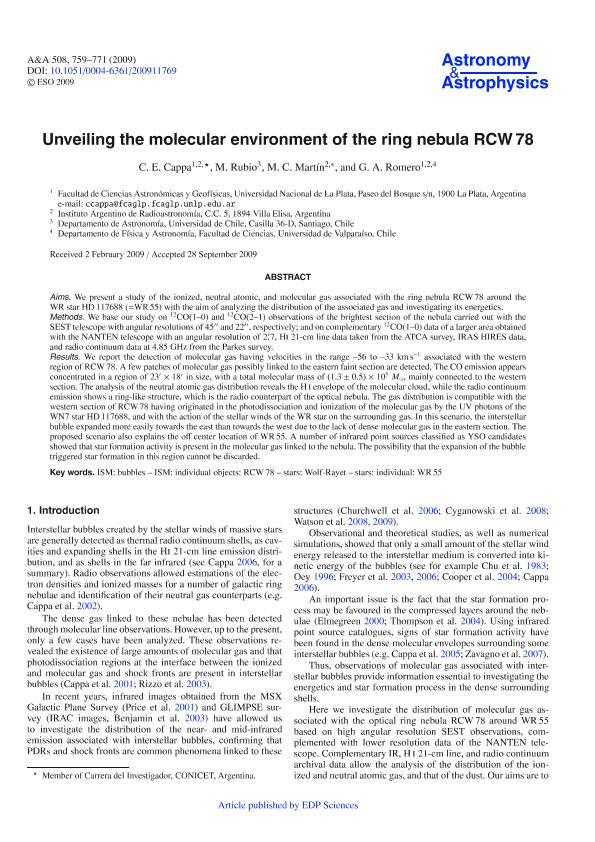Mostrar el registro sencillo del ítem
dc.contributor.author
Cappa, Cristina Elisabeth

dc.contributor.author
Rubio, M.
dc.contributor.author
Martin, Maria Cristina

dc.contributor.author
Romero, Gisela Andrea

dc.date.available
2017-10-17T18:13:53Z
dc.date.issued
2009-12
dc.identifier.citation
Cappa, Cristina Elisabeth; Rubio, M.; Martin, Maria Cristina; Romero, Gisela Andrea; Unveiling the molecular environment of the ring nebula RCW78; EDP Sciences; Astronomy and Astrophysics; 508; 2; 12-2009; 759-771
dc.identifier.issn
0004-6361
dc.identifier.uri
http://hdl.handle.net/11336/26731
dc.description.abstract
Aims. We present a study of the ionized, neutral atomic, and molecular gas associated with the ring nebula RCW 78 around the WR star HD 117688 (=WR 55) with the aim of analyzing the distribution of the associated gas and investigating its energetics. Methods: We base our study on 12CO(1-0) and 12CO(2-1) observations of the brightest section of the nebula carried out with the SEST telescope with angular resolutions of 45'' and 22'', respectively; and on complementary 12CO(1-0) data of a larger area obtained with the NANTEN telescope with an angular resolution of 2 arcmin 7, Hi 21-cm line data taken from the ATCA survey, IRAS HIRES data, and radio continuum data at 4.85 GHz from the Parkes survey. Results: We report the detection of molecular gas having velocities in the range -56 to -33 km s-1 associated with the western region of RCW 78. A few patches of molecular gas possibly linked to the eastern faint section are detected. The CO emission appears concentrated in a region of 23 arcmin×18 arcmin in size, with a total molecular mass of (1.3±0.5)×105 M_ȯ, mainly connected to the western section. The analysis of the neutral atomic gas distribution reveals the H i envelope of the molecular cloud, while the radio continuum emission shows a ring-like structure, which is the radio counterpart of the optical nebula. The gas distribution is compatible with the western section of RCW 78 having originated in the photodissociation and ionization of the molecular gas by the UV photons of the WN7 star HD 117688, and with the action of the stellar winds of the WR star on the surrounding gas. In this scenario, the interstellar bubble expanded more easily towards the east than towards the west due to the lack of dense molecular gas in the eastern section. The proposed scenario also explains the off center location of WR 55. A number of infrared point sources classified as YSO candidates showed that star formation activity is present in the molecular gas linked to the nebula. The possibility that the expansion of the bubble triggered star formation in this region cannot be discarded.
dc.format
application/pdf
dc.language.iso
eng
dc.publisher
EDP Sciences

dc.rights
info:eu-repo/semantics/openAccess
dc.rights.uri
https://creativecommons.org/licenses/by-nc-sa/2.5/ar/
dc.subject
Interstellar Bubbles
dc.subject
Rcw 78 (Nebulosa)
dc.subject
Wolf Rayet Stars
dc.subject
Wr 55 (Estrella)
dc.subject.classification
Otras Ciencias Físicas

dc.subject.classification
Ciencias Físicas

dc.subject.classification
CIENCIAS NATURALES Y EXACTAS

dc.title
Unveiling the molecular environment of the ring nebula RCW78
dc.type
info:eu-repo/semantics/article
dc.type
info:ar-repo/semantics/artículo
dc.type
info:eu-repo/semantics/publishedVersion
dc.date.updated
2017-10-04T14:55:03Z
dc.journal.volume
508
dc.journal.number
2
dc.journal.pagination
759-771
dc.journal.pais
Francia

dc.journal.ciudad
Paris
dc.description.fil
Fil: Cappa, Cristina Elisabeth. Universidad Nacional de la Plata. Facultad de Ciencias Astronómicas y Geofísicas; Argentina. Provincia de Buenos Aires. Gobernación. Comisión de Investigaciones Científicas. Instituto Argentino de Radioastronomía. Consejo Nacional de Investigaciones Científicas y Técnicas. Centro Científico Tecnológico Conicet - La Plata. Instituto Argentino de Radioastronomía; Argentina
dc.description.fil
Fil: Rubio, M.. Universidad de Chile; Chile
dc.description.fil
Fil: Martin, Maria Cristina. Provincia de Buenos Aires. Gobernación. Comisión de Investigaciones Científicas. Instituto Argentino de Radioastronomía. Consejo Nacional de Investigaciones Científicas y Técnicas. Centro Científico Tecnológico Conicet - La Plata. Instituto Argentino de Radioastronomía; Argentina
dc.description.fil
Fil: Romero, Gisela Andrea. Universidad Nacional de la Plata. Facultad de Ciencias Astronómicas y Geofísicas; Argentina. Provincia de Buenos Aires. Gobernación. Comisión de Investigaciones Científicas. Instituto Argentino de Radioastronomía. Consejo Nacional de Investigaciones Científicas y Técnicas. Centro Científico Tecnológico Conicet - La Plata. Instituto Argentino de Radioastronomía; Argentina
dc.journal.title
Astronomy and Astrophysics

dc.relation.alternativeid
info:eu-repo/semantics/altIdentifier/url/http://adsabs.harvard.edu/abs/2009A%26A...508..759C
dc.relation.alternativeid
info:eu-repo/semantics/altIdentifier/doi/http://dx.doi.org/10.1051/0004-6361/200911769
dc.relation.alternativeid
info:eu-repo/semantics/altIdentifier/url/https://www.aanda.org/articles/aa/abs/2009/47/aa11769-09/aa11769-09.html
Archivos asociados
